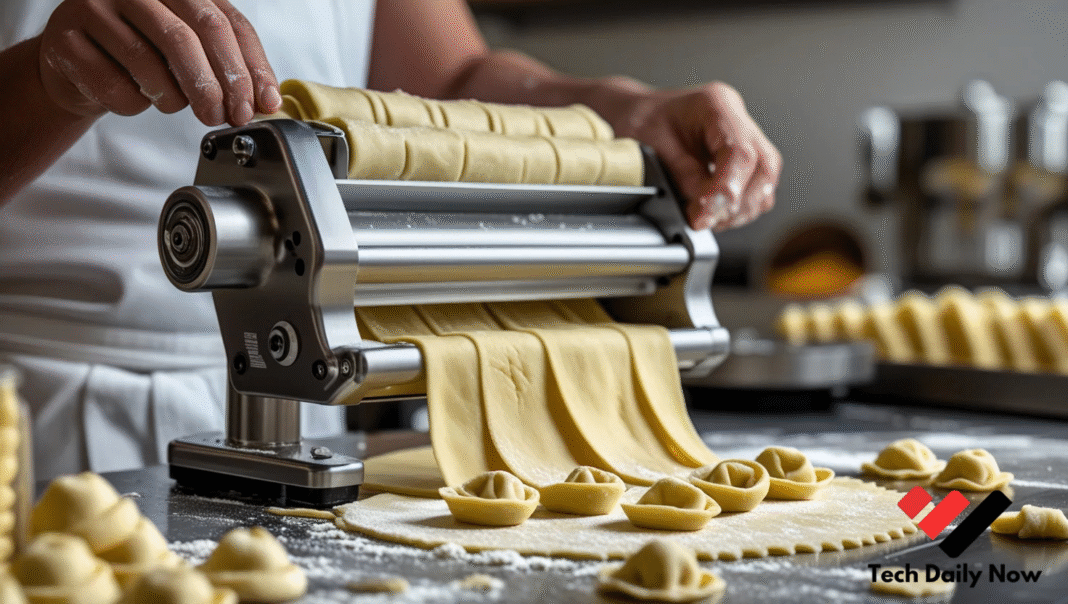The love for homemade pasta has increased in the past few years, particularly among food lovers for an authentic Italian experience in the comfort of their home. For fans of filled pasta such as tortellini, one kitchen gadget has gained notable attention—the Tortellinatrice. But is it truly worth the investment?
In this in-depth Tortellinatrice review, we will address everything one should know about this pasta machine, including its functionality, advantages and disadvantages, user reviews, and whether it is a suitable tool for your kitchen.
What is a Tortellinatrice?
A Tortellinatrice is a machine used for automating the creation of tortellini, a small filled, ring-shaped pasta that comes from the Italian region of Emilia-Romagna. While there are generic pasta rollers or cutters, a Tortellinatrice is designed specifically to remove and shape and seal tortellini with precision and repetition.
From small manual units for home chefs to larger electric or pneumatic models used in professional kitchens and factories, there are different types of Tortellinatrice machines available in the market.
Key Features of a Tortellinatrice
Let us discuss the features that make a Tortellinatrice unique:
1. Precision Molding System
The Tortellinatrice’s the primary attraction its features a precision molding system that allows uniform tortellini molding. A uniform control system makes sure that each unit is the same in dimensions and mass, which is beneficial in uniform cooking and plating.
2. High Production Speed
Even the manually operated Tortellinatrice models outperform the traditional method of creating a single tortellini. This is perfect for busy home chefs who want to prepare in bulk or small restaurants that are looking for a cost effective way to make fresh pasta.
3. Versatile Dough and Filling Compatibility
The machine is capable of processing all types of pasta dough including egg, semolina, and even gluten free variants. It also covers a variety of fillings such from traditional meat to cheese and vegetable based mixtures.
4. Durable Construction
Most reputable Tortellinatrice units are constructed of materials such as stainless steel, anodized aluminum, or food grade plastic. These materials are hygienic, prevent rusting, and are easily cleaned.
Pros and Cons of the Tortellinatrice
Similar to other investments in the kitchen, the Tortellinatrice features both advantages and drawbacks.
✅ Pros:
- Reduction in labor time for large quantities.
- Forms professional, seamless tortellini.
- Simple to operate requiring little to no user guidance.
- Ideal for enthusiasts and small businesses.
- If constructed from quality materials, long-lasting and easy to maintain.
❌ Cons:
- Not affordable—quality models can be expensive.
- Occupies counter or storage space.
- Requires some effort.
- First-time users might find it challenging.
Customer Feedback: What Are Users Saying?
Feedback from home cooks and restaurant owners regarding the Tortellinatrice has been overwhelmingly positive.
- I USED TO SPEND HOURS HAND-FOLDING TORTELLINI FOR SUNDAY DINNER. WITH THE TORTELLINATRICE, I CAN DO IT IN HALF THE TIME WITHOUT COMPROMISING QUALITY, REMEMBERS MARCO D, A NEW JERSEY BASED CHEF.
- WE ADDED FRESH TORTELLINI TO OUR MENU LAST YEAR USING A COMMERCIAL TORTELLINATRICE, AND IT’S NOW ONE OF OUR BEST-SELLING DISHES, REMEMBERS FRANCESCA L, OWNER OF A SMALL ITALIAN BISTRO.
Some beginners note it took several tries to achieve the correct consistency for the dough and the right amount of filling, but small practice batches and reading the manual proved very helpful.
Target Users of a Tortellinatrice:
A Tortellinatrice is perfect for:
Saving time for home cooks who regularly prepare pasta and frequent culinary students or professionals who want to enhance their skills.Restaurants and catering companies with a high demand for tortellini and other filled pasta require streamlined tortellini production processes.
Pasta startup companies focused on achieving replication and growth.
If tortellini production is a seasonal process or done on a limited basis, a Tortellinatrice may not be needed. However, for frequent use, it is likely to justify the purchase due to the time and effort savings it provides.
Where to Purchase a Tortellinatrice
Tortellinatrice machines can be found on specialty kitchen and Italian culinary equipment ecommerce sites, as well as on Amazon and eBay. Manual Tortellinatrice machines are sold for $100-$500, while professional electric versions go for over $1000.
Pay attention to customer ratings, the available warranty, and the availability of spare parts.
Conclusion: Is the Tortellinatrice a worthy investment?
Tortellinatrice’s investments are fully justified for passionate pasta makers and food entrepreneurs who appreciate the efficiency, consistency, and presentation benefits it brings.
Investments on a Tortellinatrice bring positive returns as production is simplified, and kitchen professionalism is heightened for those who love and seek for a handmade tortellini.
FAQs About The Tortellinatrice
Q1: Can The Tortellinatrice Use Any Type Of Filling Tortellini?
Yes. The Tortellinatrice is adaptable to a myriad of fillings such as meat, cheese, spinach, pumpkin, or even some vegan mixtures. Just be sure that filling is not overly wet or runny.
Q2: Is A Manual Tortellinatrice Difficult To Operate?
Not at all. Manual models feature ease of use at the forefront. After a few attempts, most individuals find the process simple, speedy, and efficient.
Q3: What Is The Correct Procedure For Cleaning A Tortellinatrice?
Most models have parts that can be removed which makes washing easier. As is the case with all devices, the manufacturer’s recommendations should be strictly adhered to, and soaking metal parts should be avoided as it can lead to rust formation.
Q4: Can The Tortellinatrice Create Other Shapes Of Pasta?
No. The Tortellinatrice can only make tortellini. Other shapes would require different attachments or a more versatile pasta machine.
Q5: What Kind Of Dough Should I Use In A Tortellinatrice?
Smooth, elastic dough such as all-purpose flour or pasta flour (Tipo 00) with eggs work best. Do not use sticky, overly dry dough for best results.



